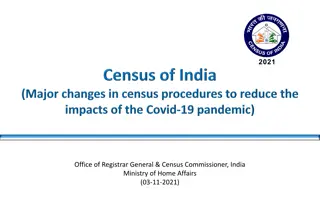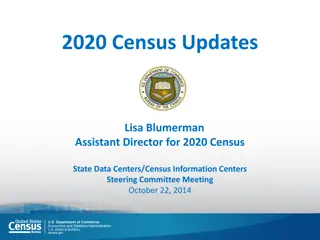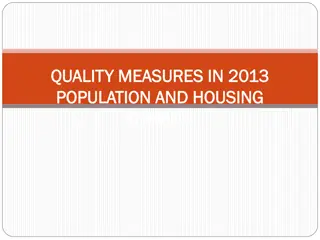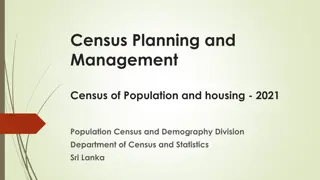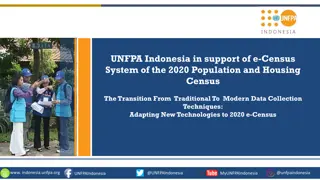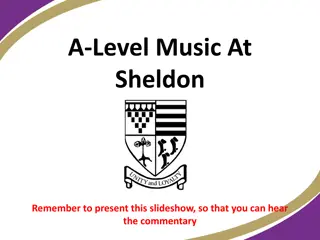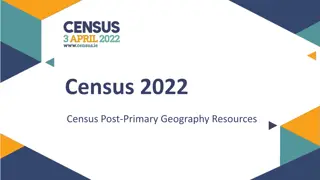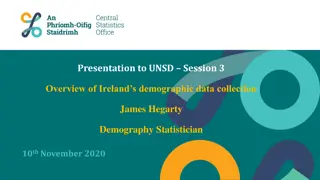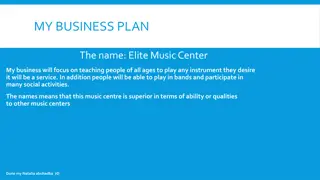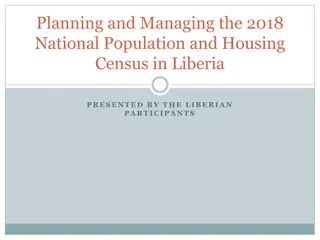Explore the Exciting World of Live Music Through [Insert Town/City] Census!
Discover the economic, social, and cultural impact of live music in your area by taking part in the first-ever [Insert Town/City] Live Music Census. This initiative aims to gather valuable data on live music activity, highlighting its significance and addressing the challenges faced by the industry. Join us in shaping the future of live music in your community!
Download Presentation

Please find below an Image/Link to download the presentation.
The content on the website is provided AS IS for your information and personal use only. It may not be sold, licensed, or shared on other websites without obtaining consent from the author. Download presentation by click this link. If you encounter any issues during the download, it is possible that the publisher has removed the file from their server.
E N D
Presentation Transcript
Welcome to the first ever [insert town/city] Live Music Census! Thank you for taking part!
Briefing session overview What is the Live Music Census? Overview of Census methodology Volunteer roles Venue observation survey Audience interview survey How to use [your survey software] Good practice for sampling ID cards Safety Volunteer agreement Data protection Checklist Any questions?
What is a Live Music Census? A census of live music activity in towns and cities, used to understand the economic, social and cultural value of live music The first UK Live Music Census took place in March 2017
Why do a live music census? Live music revenue in the UK overtook recording revenue in 2008 (Page and Carey 2009) Grassroots sector appears to be struggling 35% of grassroots music venues in London lost from 2007-2015 (Mayor of London s Music Venues Taskforce 2015) Issues facing the sector include noise complaints, gentrification and city centre development, and rising business rates BUT little known about live music activity other than PRS and UK Music data
Why do a live music census? Appetite for data from policy-makers, local authorities, economic development groups, campaign and membership groups Our starting point is that live music is important and hope that the census provides further evidence of this and the ways in which it is important
Overview of Census methodology The Census uses two main methods: (1) snapshot censuses over 24 hours starting at noon on [insert Census date] (2) online surveys targeted at musicians, venues, promoters, and audiences
How will it work? Local Census Co-ordinator Team Leader Team Leader Team Leader General Volunteer General Volunteer General Volunteer General Volunteer General Volunteer General Volunteer General Volunteer General Volunteer General Volunteer
Team Leader job description Manage small team of General Volunteers Ensure that General Volunteers sign volunteer agreement forms and for signing on/off team members at the end of each shift Collect and collate contact details for your volunteer team before collecting data Arrange time/venue to meet team after data collection for debrief/expenses After data collection, ensure that all venues data has been submitted, either online or hard copy to give to Census co-ordinator Distribute expenses if the Census HQ is closed at the end of the Team s shift
General Volunteer job description Sign in with Team Leaders at the start of shift Visit events/venues as designated by Team Leader at certain times of day/night Complete venue and audience Census night surveys work in pairs Distribute flyers to audience members asking them to complete surveys General Volunteers sign off at the end of shift with Team Leader and to debrief at HQ and receive expenses (if HQ is closed, sign off with Team Leaders instead)
All volunteers All volunteers should be able to talk about the Live Music Census in a knowledgeable way to audience members and venue staff, and to explain why it is important that they take part
Brief overview for audience Brief overview for audience interviewees interviewees What? The [insert town/city] Live Music Census is the first live music census to attempt to map live music activity in our town/city Who? It is being run by researchers at [insert institution] Why? Your data will help to understand the value of live music and help to protect it. How long will it take? The survey should take around 5 minutes. What happens to my data? Your data is protected under the Data Protection Act 1998, and will only be shared with other parties as set out in the participant information.
Collecting data Team Leaders AND General Volunteers ENSURE THAT AT LEAST ONE OF YOU IS COMPLETING THE VENUE SURVEY FOR EACH VENUE! (1) Venue Observation collect observational data at venues (2) Audience Interviews speak directly to audience members to ask them to complete surveys
Collecting observational data at venues Gather observational data about the venue and/or performance space Some of the questions require you to speak to a member of staff Surveys can either be completed online using [your chosen survey software] or via paper surveys
Collecting observational data at venues PRESENTER SHOULD GO THROUGH SURVEY QUESTIONS AT THIS POINT [insert venue observation survey URL] Any questions?
Collecting audience data at venues
Collecting audience data at venues 1) Face-to-face using volunteer s smartphone/tablet; OR 2) Hard copy survey form; OR 3) Respondents complete survey on their own tablet/smartphone devices give out flyers with links to survey URL
Collecting audience data at venues Volunteers can work through surveys with individual audience members OR to collect larger numbers of respondents, set up respondents and return to ensure completion AND give out flyers with survey links
Collecting audience data at venues Data collection some audience members do not like giving data to volunteers via smartphones Tablets work better as do hard copy surveys BUT inputting data from hard copy surveys can be time- consuming afterwards
Snapshot census date collecting hard copy surveys Volunteers should ensure that all completed hard copies have venue/event name at the top! Arrange a venue and time for volunteers (or team leaders) to meet with Local Census Co- ordinator in order to hand over hard copies
Collecting audience data at venues PRESENTER SHOULD GO THROUGH SURVEY QUESTIONS AT THIS POINT [insert audience interview survey URL] Any questions?
Collecting audience data at venues Volunteers MUST ensure that the audience member has seen and read through the participant information before they start the survey The audience member MUST click the button to say that they have read and understood the participant information before they start the survey Hard copy volunteers show the interviewee a hard copy of the participant information explain that it contains data protection information Online set up participant information on your Census website so that volunteers can show audience interviewees on their smartphone/tablet
How to use [your survey software] Design some slides to explain how to use the survey software, especially if you are using offline survey mode You may wish to build in an opportunity for volunteers to test the survey software as part of the briefing session for which you will need to set up a test survey
Survey: Practice session Go to this link and complete the short test survey Download it online Complete it offline Upload it online [insert test survey URL] Any questions?
Good practice for sampling Good practice for sampling
Good practice for sampling Good practice for sampling We can t collect data from every audience member so we need to take a sample Sample = representative portion of a population that we are interested Audience Agency (2016)
How many people do I need to How many people do I need to speak to? speak to? Ideally 30 people each per venue Ask Census co-ordinator for your individual target for each venue
1) Minimising interviewer bias 1) Minimising interviewer bias To ensure that the sample is as random as possible: Approach every second person or group passing by; If approaching a group, interview person with soonest birthday Audience Agency (2016)
2) Sampling in a crowded 2) Sampling in a crowded environment environment Position yourself near an entry/exit where steady flow of people; Try to be methodical; Walk backwards and forwards in a straight line and ask, for instance, every third person that comes within one metre. Audience Agency (2016)
2) Sampling in a crowded 2) Sampling in a crowded environment (cont.) environment (cont.) Approach people in queues and bar areas BUT don t miss out people who may use a different entrance or bar area, e.g. disabled people Audience Agency (2016)
3) How to maximise response 3) How to maximise response rates rates The volunteer needs to be properly briefed about the purpose and scope of the research; The respondent should be clearly informed about the research purpose, survey length, and incentive; The respondent should be assured of confidentiality; Be confident! Audience Agency (2016)
ID cards All volunteers will be given and should carry an ID card which needs to include your name and the signature of the Census co-ordinator to prove to venues that the volunteer is a genuine Live Music Census volunteer IT IS UP TO YOU TO ENSURE THAT YOUR ID CARD HAS BEEN SIGNED BY THE CENSUS CO-ORDINATOR!
Safety Work in pairs at all times Be aware that you are going into potentially dangerous environments Identify yourself to the venue staff Use your common sense
Safety (cont.) Look after your tablet/smartphone devices!!! Protect your hearing Avoid excessive alcohol while doing the Census! Locate the fire exits as soon as you enter the venue Ensure you consider the safety of others as well as yourself If you feel unsafe at any time, leave the venue immediately and contact your Team Leader Report any incidents to the Team Leader/Local Co- ordinator ASAP
Volunteer agreement You are participating in the [insert town/city] Live Music Census at your own risk You are using your own smartphone/tablet any loss or damage to this device is your own responsibility YOU NEED TO COMPLETE AND SIGN A VOLUNTEER AGREEMENT FORM - SEE YOUR TEAM LEADER / LOCAL CO- ORDINATOR
Data protection You are responsible for protecting the data you collect Upload (sync) surveys as quickly as possible once complete they will be automatically deleted from your device Any data you collect is bound by the Data Protection Act as set out in the participant information DO NOT SHARE THE DATA WITH ANYONE ELSE DO NOT DISCUSS THE DATA WITH ANYONE ELSE
Pre-Census checklist General Volunteers do you know which team you are on and who your Team Leader is? Do you have their contact details? Do they have your contact details? Team Leader do you know which General Volunteers are on your team? Do you have their contact details? Volunteer agreement signed and returned to Team Leader/Census co-ordinator REMEMBER TO CHARGE YOUR SMARTPHONE/TABLET!
Checklist of volunteer paperwork Survey URLs download in advance! Venue/event lists + volunteer allocation Flyers Hard copy surveys venue observation and audience interview Participant information sheets ID cards signed by Census co-ordinator Emails from promoters/venues (where required) ALSO PENS AND BAG/FOLDER FOR PAPERWORK
Thank you and good luck!
References References Audience Agency (2016) Guide | Good practice for sampling. Available from: https://www.theaudienceagency.org/insight/good- practice-guide-to-sampling, accessed 19-Dec-16. Mayor of London s Music Venues Taskforce (2015) Rescue Plan. Available from: https://www.london.gov.uk/sites/default/files/londons_grassroots_ music_venues_-_rescue_plan_-_october_2015.pdf, accessed 18-Nov-16. Mayor of London s Music Venues Taskforce (2017) Rescue Plan Progress Update. Available from https://www.london.gov.uk/sites/default/files/rescue_plan_for_lon dons_grassroots_music_venues_-_progress_update_- _jan_2017.pdf, accessed 31-Jan-17. Page, Will and Chris Carey (2009) Adding up the UK music industry for 2008 . Economic Insight, 20 July.










